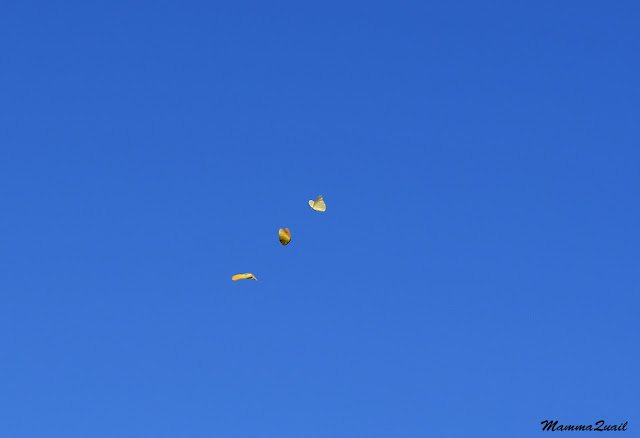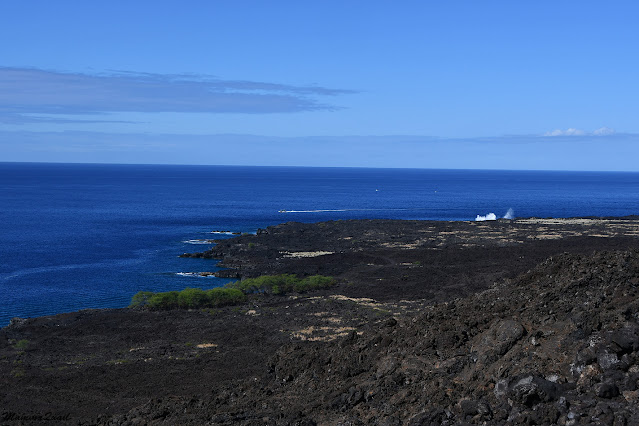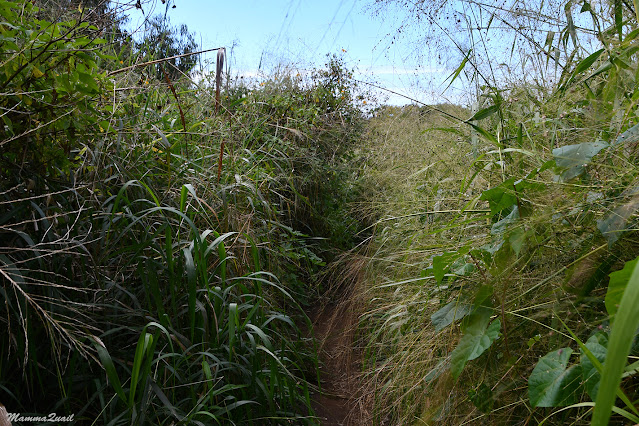Date: January 24, 2020
Place: Kealakekua Bay State Park, Captain Cook, Hawai'i, Hawaii
Coordinates: 19.492317, -155.917945
Length: 4 miles in and out
Level: strenuous
Town of Captain Cook
Park's name is: Kealakekua Bay State Historic Park. The monument is at Ka'awaloa Cove
On February 14, 1779 the amazing career of the explorer Captain James Cook came to its end when he was killed in a fight with Hawaiian warriors at Kealakekua Bay. Today there's a town there, above the ocean, named Captain Cook. The bay and the surrounding area is a state park and by the water there is a monument for Captain Cook. I wanted to visit this place already on my first trip to Hawaii 18 years ago, but it didn't happen then. I hoped to go there on this current trip with my friends but we've filled our days at the Big Island already. We hiked Kaloko-Honokōhau State Historic Park on our first day, at Hawaii Volcanos National Park on our second day, and an exploration day on the northeast side of the island on our third day. Our forth day was our last and we needed to be at the Kona airport by 1:00 pm to catch the flight to Maui. Since Captain Cook isn't far from Kona my friends suggested that we'd go there rather than pass our morning shopping or strolling on the beach. I jumped on the idea with glee and after checking out our lodge we drove south to the town of Captain Cook.
 |
| Our hike as captured by my GPS |
There is no standard parking lot near the trailhead. The trail begins just off the Napoopoo Rd. between people's home properties, in an overgrown vegetation area, and is easy to miss. There is a wide pullout on the other side of the road where cars can park and that's it. No signs, no facilities, not anything that says that this is a trail leading to a state park. There is very little traffic there, and a flock of feral chickens roam the road and its shoulders.
The trail is narrow but apparently someone did try at some point to drive there, otherwise I don't know how this vehicle reached there where it was abandoned and gutted. It was an the first intriguing thing we saw when we started down that trail.
On the first half a mile or so the trail descends at a very mild slope, between green walls of very tall vegetation, effectively concealing the town's houses on either side of the trail. There were some birds chirping about, but all we saw in terms of wildlife was a large, blue snail.
It didn't take us long to get out of the thicket though. Soon enough we found ourselves walking in a more open area of A'ā basalt, old enough to support many plants that are adapted to the exposed, hot conditions of the rock with very little soil to hold on to. One such plant was the Kalanchoe, the one that propagates itself by creating little mini-me's at the edges of its leaves. These tiny plantlets then detach and drop to the ground where they set root and continue to grow into an adult plant that is an identical genetic copy of its parent. This way of vegetative propagation must be very successful because there were carpets of that kalanchoe all around.
Apparently this method of procreation doesn't eliminate the need for sex so these plants bloom as well, and they were all blooming all over the place at the time of our hike.
 |
| Kalanchoe |
there weren't many trees along that part of the trail and the trees we did see were mostly acacia-looking trees of a species I didn't recognize yet. These trees cast a very thin and ineffective shade. On our way down however, we didn't mind the lack of shade.
Then the trail dropped downhill in a steep grade. Below is lay the beautiful coast and the deep blue ocean lapping at the dark basalt ground (header photo of this blogpost). Directly below us was a small grove of palms and I assumed there was a fresh water source there. A spring, maybe.
Most of the way down the slope was largely bare rocks. There was non need for any
say on trail' signs. The A'ā rocks looked very hostile and uninviting.
While still high above sea level we had a fantastic view of the southwestern coastline of the Big Island, and we could see the western slope of Kilauea descending mildly into the ocean.
 |
| Southwest Coastline |
A small group of butterflies erupted into the air nearby. They seemed to be chasing one another. I tried to capture them in the air and out of many blurry shots, one came out sot of near focused. It was a pretty sight to look at.
 |
| Butterflies |
The trail got even steeper and we descended quickly, dropping down towards the green-belted blue. I couldn't tell our destination from where we were but I was already eager to get into the ocean.
Getting down was quick. Then we turned south and walked a short distance on a level trail that was shaded by trees of several species, and some decorative bushes that I,m not sure were planted there on purpose.
 |
| Madagascar Periwinkle, Catharanthus roseus |
There were evidence of people use of this place all over. There were many discarded beach items turned trash that gave the impression of an abandoned hippy joint. The thing that made it look most like a cheap hangout place was a stray cat that roamed around, looking of something to eat in the human leftover junk.
As we neared the Captain Cook monument we started seeing people as well. There were a number of people in swimsuits and other beach attire sitting on the rocks around the monument. The real impressive sight was the bay itself: a couple of tour boats anchored near the shore and numerous human forms were floating face down with plastic pipes protruding from the sides of their heads.
We of course, had full intention of joining the snorkelers. Before doing that however, I wanted to look at the Captain Cook monument, the primary reason for us going there.
Captain Cook was a true explorer. Although he was a military man, he never took part in any conquest wars. Moreover, in all of his encounters with the native populations of the Pacific he kept the interactions respectful and straight forward, and enforced proper behavior on his crew. It is thought that the fight in which he lost his life started because of a cultural misunderstanding rather than a deliberate act of aggression on either side. Despite all that's known about Cook, the contemporary Hawaiians are irked by the Cook's memorial, because they see him as the one who opened the door to the stream of white settlers that eventually led to the loss of Hawaiian independence and the diminishing of their culture.
 |
| The Cook Memorial |
We changed to swimsuits, strapped the goggles and snorkel on our heads and stepped in the water. I had my underwater camera with me and immediately I begun putting it to good use.
My first use of this camera at the north beach of Kaloko-Honokohau State Historic Park produced only laughable results. There is was wavy, and there wasn't much to see underwater. Now it was altogether different and I got much better results.
For a start, there was a lot to see. It wasn't a hugely rich reef but there was a good number of colorful fish swimming about. The fish didn't mind the people much. Occasionally one would come near to stare at the big floating human but mostly they just went about their business, completely disregarding us.
 |
| Pinktail Triggerfish |
It has been a long while since the last time I had used a snorkel. 18 years, to be exact. So it took me some time to become comfortable with this activity. Comfortable enough to dive deeper in search of interesting life at the bottom.
It was an effort to get all the way down to the sea floor but the effort was well worth it. There were fish there that didn't swim far above the rocks and corals. There were also sea urchins of at least two kinds. It was very cool to see.
I could have stayed there the entire day if I had the time. I stayed in the water long after my friends had had enough and went to sit on the rocks. When I finally got out of the water and checked the time I started panicking - we had to get going right away if we wanted to catch our flight to Maui. We changed quickly and starting up the trail, backtracking the same way we came down with.
 |
| Kalanchoe on basalt rocks |
Driven by urgency we quickly ascended the first, steeper part of the trail. But it was a very hot day and the trail was exposed so we soon got winded and had to slow down and pause frequently to drink water. These pauses gave me some time to look at the surroundings again, and appreciate the views and the interesting shapes of the lava flow, long solidified.
It was mid day and the sun was blazing right on top of us. That's what happens when you're hiking closer to the equator than your usual placed. The thin trees cast very little shade. Me and one of my friends were slowing down. My other friend, who was in much better shape, got frustrated with our slow speed and decided to go ahead back to the car. Half jokingly I warned her not to stop on the way lest she'd fall asleep and we'd beat her to the car.
My friend chuckles and got going, and soon disappeared around the curve. Me and my other friend continued uphill at a much slower pace. I put off any worry of missing the flight out of my mind - it was pointless to think of it now. We first needed to get back safely.
The slow pace allowed me to take a closer look at those trees that I couldn't identify at first sight. It was then that I realized that the pods hanging from the branches looked very familiar to me - these were tamarind pods! We were walking through a grove of tamarind trees, and Indian species that was introduced to Hawaii and established itself in the wild there.
 |
| Tamarind, Tamarindus indica |
Island weather can change fast, especially in the winter. At we walked on, clouds started gathering on the east and they were creeping westward towards us. It was hot still, but the trail became less steep now and the vegetation thickened again with bigger trees shading more segments of our trail.
We were walking quicker now. I didn't want to stop any more. I just wanted to get to the car and rush to the airport, but a large tree with strange looking fruit grabbed my attention and I diverted to it momentarily to get a quick look at these fruit. There was a low stone fence behind the tree and I caught a glimpse of something white lying on the fence, mostly hidden by the large trunk of the tree. I stepped closer to see what that was and then started to laugh uncontrollably.
 |
| Autograph Tree, Clusia rosea |
Aesop, the ancient Greek story teller has a fable about a rabbit and a tortoise that raced each other. The rabbit had a quick start but near the end he decided to take a break and wait for the slow tortoise so he could brag and taunt him. While waiting however, the rabbit fell asleep, and the slow, but steady-going tortoise eventually passed the rabbit and won the race.
The white 'thing' on the stone fence behind the tree was a hat and underneath it lied our fast friend, fast asleep. I guess if we really had the time I might have let her sleep it off while waiting at the car. We didn't have the time to savor our tortoise victory however, so we woke her up and the three of us went on, not before I chided her for hiding so well - it was impossible to see her from the trail. Had I not decided to take a closer look at the tree we would have missed her altogether.
 |
| A fine resting place under the Autograph Tree |
I looked at my watch again. We actually did a good time on our way up and I was more relaxed and less worried that we might miss the flied. We went on at a better pace now, but I did allow myself brief poses to check out some flowers that I missed on the way down.
 |
| Pigeonberry, Rivina humilis |
The wind picked up and a big cloud covered the sky. Strangely enough, the heat remained. We were getting close to the end of the trail now, and could see the town's palm trees swaying in the wind.
The top part of the trail is a thin line between thick walls of vegetation. High grasses mostly, but many others, including some familiar looking vines. It was nice not to have to worry about poison oak, the Californian hiker's bane.
The familiar looking vine turned out to be bitter melon, another Asian crop plant that was introduced to Hawaii and established itself in the wild (and the only vegetable so far that I couldn't develop a taste for).
The chicken flock in the parking area had grown and I counted more than ten of them, mostly hens and chicks. I took a few photographs but we didn't have the time to linger there any longer. We got into the car and drove off to the Kona airport. We made it there in time to catch our flight.
I think that If I was doing this trip with Pappa Quail and the chikas we probably wouldn't have gone to Captain Cook's monument under the time constraints we've had. It was a very time-tight hike with very little buffer time. I am very glad that we did it though. It was a place I really wanted to see and a perfect end to our time in the Big Island. It was also a reminder that four days is really too little time to see this island's wonders. I want to visit it again.






















very nice underwater pictures. I also liked the butterflies' pictures.
ReplyDeleteGood you made it to your flight...
Thank you! Yes, I'm happy that we caught the flight too. We had some nice hikes in Maui as well.
Delete